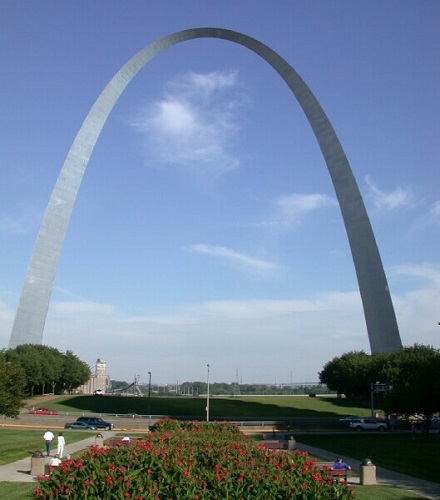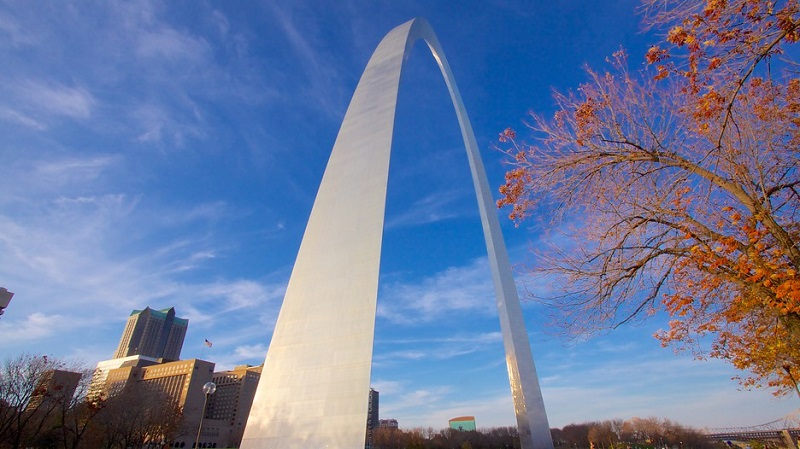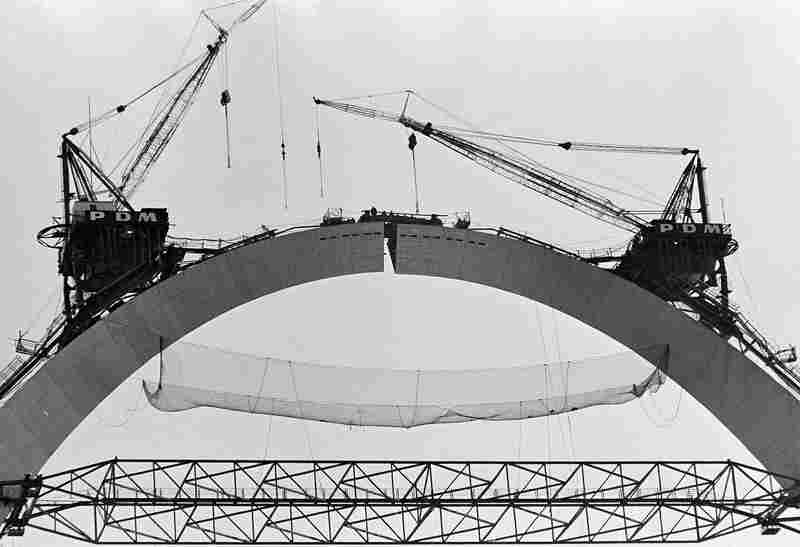Gateway Arch
Contents |
[edit] Introduction
The Gateway Arch is a structural expressionist monument located on the west bank of the Mississippi River in St. Louis, Missouri. It was built as a monument to the westward expansion of the United States. At 192 m (630 ft) in height, it is the world’s tallest arch, and the tallest man-made monument in the Western Hemisphere.
The idea was conceived as part of the Jefferson National Expansion Memorial (JNEM), created in 1935. A nationwide design competition was held in 1947/48 and Ero Saarinen’s arch was chosen as the winner. Since its completion in 1965, it has become a popular tourist attraction and a defining symbol of the city of St. Louis.
[edit] Design
Eero Saarinen conceived of the monument as being clad in stainless steel and built in the form of an inverted, weighted catenary arch, a shape such as would be formed by a heavy chain hanging freely between two supports.
The arch spans 192 m (630 ft) between the outer faces of its triangular legs. Each leg is an equilateral triangle, narrowing from 16 m (54 ft) per side at the bases to 5.2 m (17 ft) at the top. Complex mathematical equations were required to ensure the arch design would work, and the base of each leg at ground level had an engineering tolerance of just 0.4 mm (1/64 inch) to ensure they would meet at the top.
Each leg consists of a stainless steel skin covering two carbon-steel walls with reinforced concrete sandwiched between them. This continues until 91 m (300 ft), at which point carbon steel stiffeners are used instead of concrete. These inner and outer stressed-skins join to form a composite structure which carries the self weight and wind loads to the ground.
Each leg is embedded in concrete foundations 13 m (44 ft) thick and 18 m (60 ft) deep. The arch is earthquake-resistant and designed to sway up to 46 cm (18 inches) in either direction, while withstanding winds of up to 150 miles per hour.
The arch is hollow and accommodates a tram system that carries visitors from the lobby to an observation deck at the top. Operating at the rate of 340 ft per minute, the ride takes 10 minutes for the full trip. The observation platform is 65 x 7 ft, and fitted with plate-glass windows that provide views to the east and west.
[edit] Construction
Construction was postponed during World War II, and it wasn’t until 1959 that ground was first broken. The foundations were laid in 1961, and the arch construction itself began in 1963 as the first steel triangle for the south leg was moved into place.
The steel triangles, narrowing as they spiralled to the top, were raised into place using a group of cranes and derricks. Once in place, each section was filled with concrete and prestressed with 252 tension bars. As a means of keeping the partially-completed legs steady, a scissors truss was placed between them at 160 m (530 ft). This was later removed as the derricks were dismantled.
Construction progress was delayed by a combination of funding issues, safety checks and legal disputes. Civil rights activists brought work to a stand-still as strikes were held in protest against the fact that African-American workers, who were being discriminated against, were working on the project.
On October 28 1965, the arch was finally topped out. The keystone was a 2.4 m (8 ft) long triangular section. To mitigate against thermal expansion, which had constricted the gap at the top by 13 cm (5 inches), fire hoses were used to spray water to cool the surface and help it contract. When the keystone was in place, a hydraulic jack was used to pry the legs apart 1.8 m (6 ft), with the final section being inserted to secure the arch.
Having cost $13 million (equivalent to $190 m in 2015), the arch opened to the public in June 1967.
[edit] Find out more
[edit] Related articles on Designing Buildings Wiki
Featured articles and news
RTPI leader to become new CIOB Chief Executive Officer
Dr Victoria Hills MRTPI, FICE to take over after Caroline Gumble’s departure.
Social and affordable housing, a long term plan for delivery
The “Delivering a Decade of Renewal for Social and Affordable Housing” strategy sets out future path.
A change to adoptive architecture
Effects of global weather warming on architectural detailing, material choice and human interaction.
The proposed publicly owned and backed subsidiary of Homes England, to facilitate new homes.
How big is the problem and what can we do to mitigate the effects?
Overheating guidance and tools for building designers
A number of cool guides to help with the heat.
The UK's Modern Industrial Strategy: A 10 year plan
Previous consultation criticism, current key elements and general support with some persisting reservations.
Building Safety Regulator reforms
New roles, new staff and a new fast track service pave the way for a single construction regulator.
Architectural Technologist CPDs and Communications
CIAT CPD… and how you can do it!
Cooling centres and cool spaces
Managing extreme heat in cities by directing the public to places for heat stress relief and water sources.
Winter gardens: A brief history and warm variations
Extending the season with glass in different forms and terms.
Restoring Great Yarmouth's Winter Gardens
Transforming one of the least sustainable constructions imaginable.
Construction Skills Mission Board launch sector drive
Newly formed government and industry collaboration set strategy for recruiting an additional 100,000 construction workers a year.
New Architects Code comes into effect in September 2025
ARB Architects Code of Conduct and Practice available with ongoing consultation regarding guidance.
Welsh Skills Body (Medr) launches ambitious plan
The new skills body brings together funding and regulation of tertiary education and research for the devolved nation.
Paul Gandy FCIOB announced as next CIOB President
Former Tilbury Douglas CEO takes helm.
UK Infrastructure: A 10 Year Strategy. In brief with reactions
With the National Infrastructure and Service Transformation Authority (NISTA).

























